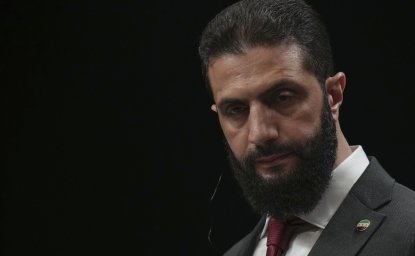How a Conflicted Iran Undercuts Its Own Regional Ambitions
Iran’s invitation to join this week’s international talks about Syria’s future underscores Tehran’s success turning itself into a major regional player.
Iran’s invitation to join this week’s international talks about Syria’s future underscores Tehran’s success turning itself into a major regional player.
Iran’s invitation to join this week’s international talks about Syria’s future underscores Tehran’s success turning itself into a major regional player. Iran, the largest and most powerful of the Persian Gulf states, has long wielded considerable influence in Lebanon and Iraq; now it is forging ties and coordinating regional policy with Russia. Foreign Minister Javad Zarif will lead the Iranian delegation in Vienna, joining his Saudi counterpart, Adel al-Jubeir, at the same table. Yet Iran’s foreign policy, however skillful, is not of one piece.
There are competing currents in the Iranian leadership. The so-called moderates, associated with President Hassan Rouhani’s government, and the hard-liners, linked with Ayatollah Ali Khamenei and the Revolutionary Guards, share a belief in Iran’s right to a large regional role. But the moderates have other priorities too, including reviving the economy, attracting foreign investment, and winning friends in the U.S. They rely more on diplomacy and negotiation. The hard-liners, meanwhile, are committed to projecting Iranian power through military means; they attach little importance to the unease they cause among Arab states and remain hostile to the U.S. The Iranian government’s desire for better ties with Arab neighbors and its aspiration to benignly acknowledged regional leadership is persistently undercut by its ambitions.
When he was elected in 2013, President Rouhani made a point of reaching out to Iran’s Persian Gulf neighbors. He sent Mr. Zarif on a tour to mend strained relations with smaller Gulf states; President Rouhani also reached out to his “brothers” in Saudi Arabia. When the deal over Iran’s nuclear program was reached with world powers this summer, President Rouhani sought to reassure Gulf states worried that Tehran would be emboldened to engage in what they see as further mischief in the region. “#Iran & its power will translate into your power,” he tweeted. But such sweet talk and the charm offensive have done little to narrow the divide between Iran and its neighbors.
The Arab states of the Gulf, particularly Saudi Arabia, think Iran aims for nothing less than regional hegemony. They have watched apprehensively as Iran built a powerful militia in Lebanon and, on a smaller scale, in Iraq. In Syria, Iran–along with Russia–supports beleaguered President Bashar al-Assad with money, forces, and weapons; Saudi Arabia and its Arab allies support Mr. Assad’s opponents and want him out of power. Iran and Saudi Arabia also support different sides in Yemen’s civil war. Arab governments believe that Iran supports the Shiite opposition in Bahrain.
These rivalries have fueled sectarian conflicts. There is enough blame to go around on all sides, but what matters is that, increasingly, Shiites and Sunnis across the region are lining up against one another.
Iran’s muscle-flexing has come to be identified with Gen. Qasem Soleimani, commander of the Qods Force, the foreign operations arm of the Revolutionary Guards. Gen. Soleimani has been much more visible since President Rouhani took office. He was photographed earlier this year alongside Kurd and Shiite militias in the battle for Tikrit against Islamic State in Iraq. He was recently detected guiding Hezbollah and Iraqi militias on the outskirts of Aleppo. He visited Moscow just before Russia began its interventions in Syria, presumably to coordinate military planning.
In Iran, the ultimate decider on foreign policy issues is the supreme leader. He has been the architect of Iran’s interventionist policy in Iraq, Lebanon, and Syria, and of Iran’s support for Shiites elsewhere in the Middle East. He believes strongly in the projection of Tehran’s regional power. He wants the U.S. presence in the region to be diminished, preferably eliminated.
That said, Ayatollah Khamenei has not been totally inflexible on these issues. He finally endorsed the international agreement over Iran’s nuclear program. He has ruled out bilateral talks with the U.S. on diplomatic, economic, cultural, and regional issues, but he went along with Iranian participation in the current consultations about Syria. He has warned against U.S. cultural and economic penetration, but he has not objected to the parade of European ministers visiting Iran in search of economic opportunities.
Such a balancing act–sometimes skillful, often wobbly–has come to characterize Mr. Khamenei’s foreign policy. The leverage afforded by the projection of military muscle has undeniably advanced Iranian foreign policy goals. But differences among Iran’s leaders over the conduct of foreign policy, and the reaction of the international community, suggest a choice is inevitable. Iran can elect to mute its regional ambitions in the interests of better relations with neighbors, resolution of regional conflicts, and economic growth–or it can choose to sacrifice these goals in pursuit of regional dominance.
This article originally appeared in the Wall Street Journal's Think Tank Blog: http://blogs.wsj.com/washwire/2015/10/29/how-a-conflicted-iran-undercuts-its-own-regional-ambitions/.


The Wilson Center’s Middle East Program serves as a crucial resource for the policymaking community and beyond, providing analyses and research that helps inform US foreign policymaking, stimulates public debate, and expands knowledge about issues in the wider Middle East and North Africa (MENA) region. Read more


